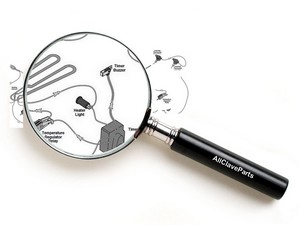Finding Pressure Leaks on Newer Midmark Autoclaves
Inside The Water Reservoir
The following Error Codes are indicative of a Pressure leak
- C534, C544, C573, C574, C575
- C633, C634
- C980, C981, C982, C983, C985
Pressure leaks include the ones that are visible: Steam coming out around the door (faulty Door &/or Dam Gasket,) and Puddling underneath towards the rear of the autoclave (the Pressure relief valve is leaking)
If no problems are found in these obvious areas, then it is time to dig a little deeper

Caution: Unplug the autoclave from the wall outlet before proceeding
To complete this procedure, the only tool you need is a screwdriver
During this procedure, you will be watching inside the water reservoir for symptoms. Most pressure leaks will be found here and, with our help are easliy identifiable
Let's get started

- Remove the left hand side panel as you are facing the autoclave (it's the same side where you add water) by removing the two screws located on top of the unit, just above the side panel
- Then, lift out the side panel and set it aside
- After removing the side panel, you will then have access to the water reservoir. Your area of observation is inside the larger reservoir. To get access to the inside of the reservoir so you can watch for symptoms, notice there is a plastic lid and rubber seal....both must be removed first so you can look inside

- Remove The Plastic Lid
- This is done by sliding the plastic lid slightly to the rear of the autoclave (about an inch).

You can then lift up on the side of the lid that is facing you and rotate it until it is clear of the reservoir.

Then, set the plastic lid aside

Remove the Rubber Seal

With the plastic lid removed, it reveals the rubber seal. Just lift up on the corner of the seal, "peel" it off and set it aside

You are now ready to get started with locating and diagnosing the problem.

We have removed the top cover of the autoclave to give you a clearer picture of the area you will be watching. The top cover must be securely in place before proceeding with the test

We are now ready to test the unit. And this part really is simple. All you will be doing is mostly just watching. So, let's get started with the test
There is a chance there will be steam coming from the reservoir.....so, Protect your eyes by wearing safety goggles during this test
- With the side panel, the plastic lid, and the rubber seal removed....Plug the autoclave back into the wall outlet
- Start a cycle
- After the unit has completed filling and advances to the heat up mode, take a pencil and mark the water level on the outside of the (plastic) reservoir. Check on the water level inside the water reservoir duing the cycle. If the level goes above the pencil line you drew, then the fill valve is malfuntioning and will need to be replaced.

As it approaches 240°F, Watch the end (with the hook on it) of the condensation coil inside the reservoir

If you see steam coming out the end, then your air valve is leaking and needs to be repaired or replaced

But if you see water coming out the end of the condensation coil, then the vent valve is leaking and needs to be repaired or replaced

If you see bubbling coming from anywhere along the bottom, then the fill valve is leaking and needs to be repaired or replaced
















































